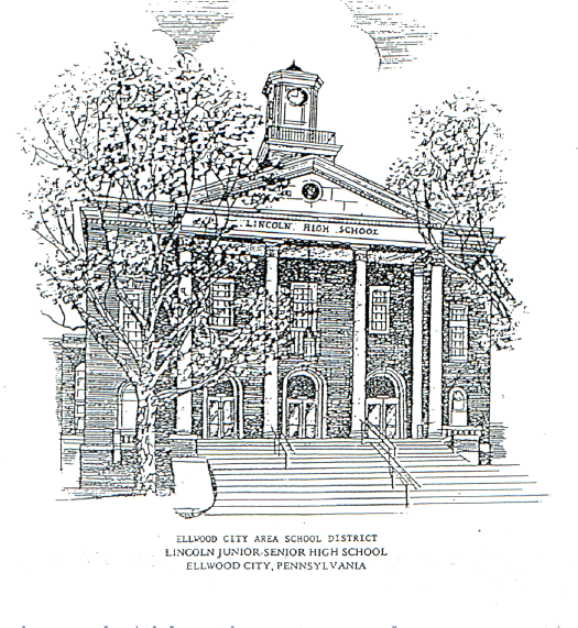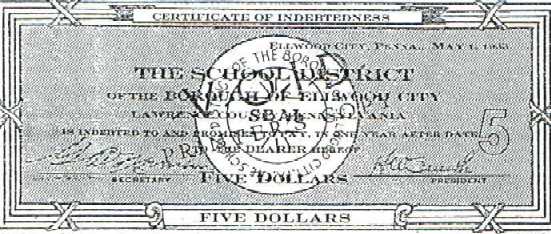Ellwood City, Pennsylvania, Depression Scrip
 Ellwood City School
Ellwood City SchoolEllwood City, Pennsylvania, is a small town in southern Lawrence County about 50 miles Northwest of the city of Pittsburgh. In May of 1933, the Ellwood city school District issued certificates of indebtedness that until recently were unknown to the collecting public.
The sequence of events that led to Ellwood city school District's issuance of scrip began as early as April 27, 1932, when the minutes of the meeting of the Board of School Directors reported approximately $100,000 in unpaid taxes. Auditors were called in and were unable to balance the books noting that "carelessness was evident." On May 3, 1932 the auditors reported that "a large number of unopened letters were found." There were also a "number of checks payable to the school district discovered in an accumulation of papers." As a result of the auditors' findings, a special meeting was held on May 25, 1932 where a per capita tax and ·a 4 3/4 mill property-tax were discussed to correct the financial mess. No action was recorded on either option. The following month was crucial. In June the school district was faced with making a large payment to cover the 1925 Series bonds used to build Lincoln High school.
The Board withdrew the mortgages of seven properties from the First National Bank of Ellwood City as a quick solution to their cash flow problem. Instead of acknowledging their dwindling tax reserves, the Board extended the deadline for the payment of delinquent taxes. They apparently shelved the issue in favor of more pressing concerns because they replaced the Superintendent and the Board Secretary in July. The Board withheld the Superintendent's paycheck and charged the former Board Secretary for a shortage of funds. Facing an erosion of public confidence, the board addressed the delinquent tax issue with caution. In the words of one school Board member, they "did not want to force collection all taxes, and have some of our good citizens lent to jail." So, in August, instead of collecting taxes, the tax collector prepared exoneration lists.
Still sensing something wrong, the Board audited the tax collector. When discrepancies were reported in his records, they fired him and took legal action. Having put their house in order, the Board finally turned their attention to the tax problem. Unfortunately, it was now October, and six months had passed without action on delinquent taxes. A review of the records reveal that the Board resolutely filed liens against properties owing two years worth of taxes and declared that the teachers would "contribute" ten percent of their salaries. By November, they made an effort to generate income by adopting an installment plan for delinquent taxpayers.
With new impetus to collect taxes, a strange turn of events came about in December when, according to Pennsylvania school law, new school board members took office. The new Board reversed the old Board's policy and once again extended the payment deadline for back taxes! The politics are uncertain at this point, but a full two months passed with no significant action until February 9, 1933 when the Board prepared papers for a $50,000 bond issue. By March, the situation deteriorated to such an extent that at least one teacher’s check bounced. Yet, surprisingly, the deadline for delinquent tax payments was again extended. Furthermore, the Citizen's National Bank in Ellwood City went into receivership and the school district had to initiate action to recover the bonds that were held through the Bank. With no cash on hand and taxes not due now until June, a deficit of $75,063.23 was forecast for the year. This estimate was low since it took into account revenues generated by the $50,000 bond issue and a further reduction in teachers' salary of twenty percent.
In April, when the amount of delinquent taxes grew to $143,320.76, the Board was devastated to find out that the bond issue did not sell. The 4% yield was too low to attract buyers. They immediately borrowed $25,000 to operate the school until the end of the fiscal Year (June 30, 1333). This $25,000 formed the basis for issuing the certificates of indebtedness, or scrip. Printer's proofs were submitted to the Board on April 13, 1933 and the notes were printed.
 Five Dollar Scrip
Five Dollar ScripThings were looking up for the school district in May when they re-funded the unsold bonds at a higher rate. The bonds sold and they issued the scrip but the scrip was refused by the Ellwood City Borough Council. The Ellwood City Ledger reported on June 3, 1933 that the local merchants appeared before City Council and urged the city's acceptance of the scrip for taxes and electric lights. The solicitor for the borough argued that it was not legal tender and he pointed out that, according to law, such payments (i.e. taxes and utilities) must be made in legal tender, not scrip. In spite of the school board solicitor's attempt to affirm the district’s authority to issue scrip, the Council rejected the scrip in a 5-2 vote.
Borough Will Not
Accept Scrip Of
School District
Plea of Local Merchants
To Accept Scrip
is Defeated By a
5-2 Vote
The Ledger Reports
So, the merchants found themselves accepting scrip while the Borough collected cash. In the words of Mrs. Anna Brewer, whose name appears on the envelope containing the discovery notes, "Mr., Hancher (the Board Secretary) had quite a time with them (scrip). Teachers couldn't go out of town... they couldn't pay taxes."
In summary, a combination of events appear to have forced Ellwood City School District into issuing depression scrip. First, there was questionable behavior on the part of three key persons associated with the School district: a tax collector, a former school Superintendent, and a former School Board Secretary. Second, the school district lost money in a failed bank and miscalculated the percentage rate on a much needed bond issue. Third, and perhaps most significantly, the Board put off delinquent tax collection until it was too late.
The existence of the scrip came to light when the author purchased an envelope containing four printer's proofs: three five-dollar denominations and one ten-dollar denomination. Each note was overprinted on its face in red "/V/O/I/D/ PRINTER'S COPY" in two lines. The proof, or specimen notes, are printed on heavy white paper while records indicate that the actual issue was "bound in perforated books, and numbered consecutively by corresponding numbers on each certificate, and stub thereof." The five-dollar notes are printed in royal blue ink while the ten-dollar notes are orange. A one-dollar specimen note printed in light green was discovered later. Research reveals that only three denominations were issued: ones, fives, and tens. According to school district records the total issue was broken down in the following manner:
10,000 of the par value of $1.00 each totaling $10,000
2,000 of the par value of $5.00 each totaling $10,000
500 of the par value of $10.00 each totaling $ 5,000
1,500 Notes issued Total value $25,000
The face of each note displays the seal of the Ellwood City School District. The signature of H. W. Smith, school board President, is in the lower right hand corner and the signature of G. B. Hancher, school board Secretary, is in the lower left corner. Only one specimen note (purchased by the author from a former school employee who saved it from the incinerator) shows a partial serial number in the upper left corner. The complete serial number, 11018, is visible only when the note is turned sideways.
The back features a statement of indebtedness as well as a view of Lincoln High School, built in 1926, and still in use today. All specimen and regular- issue notes were printed by the Steele Print Shop in Ellwood City. The Steele Print Shop is still in operation, unfortunately, the present owner reports that early company records concerning the scrip were discarded sometime on the mid 1950’s.
Mr. Marshall, deceased, was a prominent citizen whose son was an elementary school principal for some years in the Ellwood City School District. Mrs. Brewer and Mrs. Rouse are former school secretaries who presently reside in Ellwood City. When questions concerning the whereabouts of the notes were put to Mrs. Rouse, she said that when the archives were cleaned out (ca. 1944) she received permission from Superintendent J. Ellis Bell to give Mr. Marshall some of the notes. "Others were destroyed" in her words, but she believes that some may be in the hands of individuals who did not redeem them.
When asked, Mrs. Brewer corrected the notation on the envelope reporting that she did not, in fact, destroy the scrip. They were destroyed by G. Glaine Hancher, the school board Secretary. Mrs. Brewer described the redeemed scrip as being "packed in a box ... probably destroyed." She also recalls that some notes were not redeemed. This was verified in a school district audit entry dated June 30, 1937. It recorded a total of $15 worth of unredeemed scrip. The denominations of the notes that remain outstanding cannot be verified since the ledger containing that information is unavailable. Mrs. Brewer seems to recall that only one-dollar notes remain unredeemed. She speculates that higher denominations would have represented too large a sum to sacrifice for a souvenir during the Great Depression.
Since the discovery of the first four notes, a set of specimen notes have surfaced along with a single five-dollar note. It appears that all that remains of the printer's proofs submitted in April of 1933 are two ten-dollar specimen notes, five five-dollar specimen notes and one one-dollar note. Repeated efforts to confirm the existence of any of the unredeemed notes have failed.